By Frank C. Montagna
At a fire or an emergency scene, the chief evaluates conditions, makes decisions, and assigns fire companies to perform tasks. He identifies and considers hazards, striving to keep his firefighters safe while they perform their assigned duties. How, when, and why he assigns them to specific tasks depend on his standard operating procedures (SOPs), his experience, his training, his study of fire-related material, his response area knowledge, his ongoing size-up, and the capabilities of the units that he commands. The chief’s decisions are only as good as the information he already has and whatever new information he gathers on the scene.
As a student, he has prepared himself through books, classes, and experience. He gathers additional data using his eyes, ears, and nose when responding to and operating at an incident, by radio, face-to-face reports, and observation. But the firefighters operating at the scene are perhaps his most important source of information. Based on this all these data, he initiates or changes his strategy and tactics (photo 1).
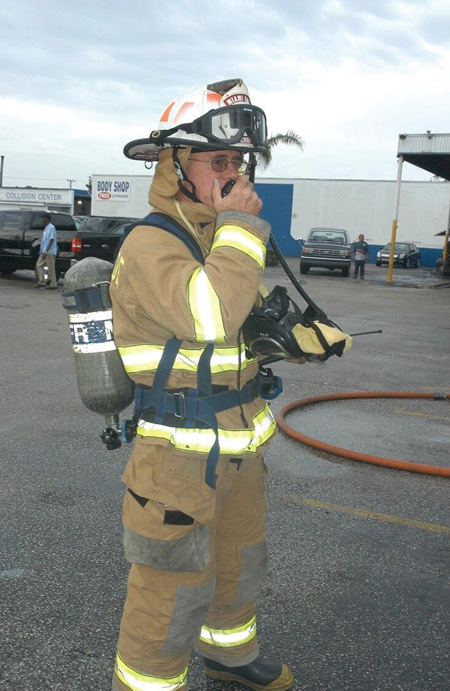
(1) Photo courtesy of Miami-Dade (FL) Fire Rescue.
Firefighters can see all four sides of the incident for the chief when it is not possible or practical for him to walk around the building. A firefighter on the roof can look down over the rear of the building and report any relevant information. Firefighters can inform the chief of rapidly changing conditions, information that may be obtainable only from the structure’s interior.
If the chief receives faulty, inaccurate, or delayed information, his decisions can result in disaster. Reporting the wrong location for a missing member delays finding him. A delayed or absent report of an existing collapse potential can result in a deadly collapse. Failing to notice and report fire extension can result in rapid and unexpected fire spread, putting firefighters at risk.
It is every firefighter’s duty to ensure that the chief receives timely, accurate, and continuing information. This flows through the company officer normally. If every firefighter reported everything to the chief, it would overwhelm him with much that is inconsequential and possibly mask that which could have severe consequences. Typically, a firefighter sees something and tells his officer, who evaluates it and then, if he deems it necessary, relays it to the chief. The officer is the filter that allows only pertinent and necessary information to reach the chief.
In some cases, reporting directly to the chief is warranted. A firefighter who notes a hazard but is unable to contact his officer can report directly to the chief and respond directly to the chief’s inquiries (photo 2).
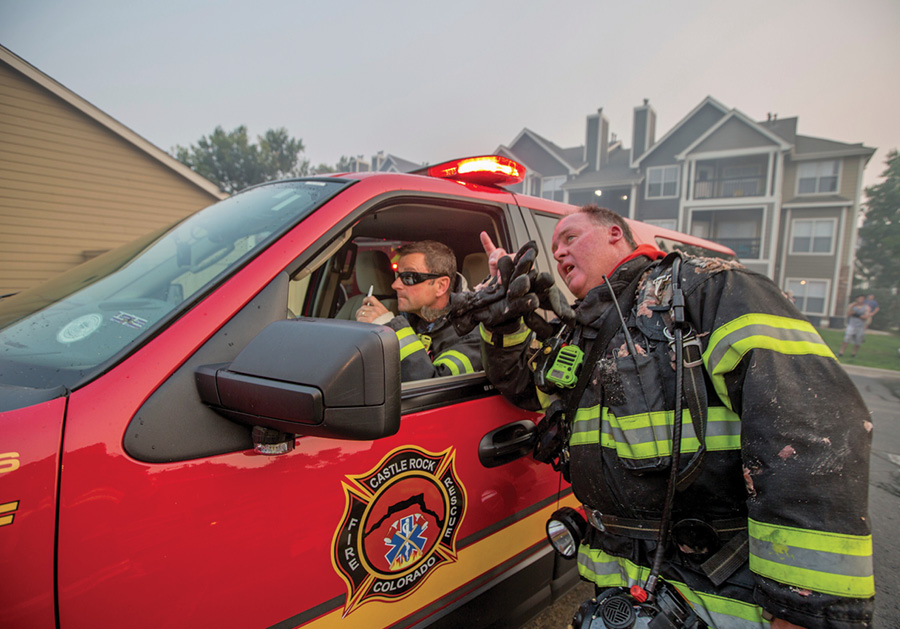
(2) Photo by Eric Hurst.
https://emberly.fireengineering.com/articles/fire_life/articles/2013/february/keep-it-all-in-perspective-part-3.htmlThe chief gathers information before receiving the alarm, routinely noting the weather and traffic conditions and what effect they will have on any incidents that could occur. When assigned to an alarm, he considers any information the dispatcher relays. Sometimes he can gather more as he is responding and, on arrival, continually evaluate it and make and change decisions accordingly.
Make no mistake about it—the chief must make decisions at the scene with or without all of the information. He routinely must make life-and-death decisions based on incomplete information. By passing on relevant information, firefighters can improve his decisions.
Alarm Reception and Response
When units are assigned to respond to an alarm, they acknowledge that they have received the alarm and are responding. In some departments, this is done by pushing a button in quarters, from the apparatus, or on a mobile radio while en route. The chief needs to know that the assigned units are responding to the alarm.
As the chief is responding, he creates a mental picture of what he might expect to face when he arrives and what resources he will have available to deal with it. He formulates a potential plan on how to respond that involves various units’ expected arrival times. If one unit will be delayed, the unit should report that over the radio to dispatch. The chief will hear this and can adjust his plan accordingly.
RELATED: Conditions That Warrant Urgent Communications to Command | A Fire Officer’s Dozen | Clarity Should Be Goal of Radio Codes
Any reduction in unit strength or any tools and equipment that are out of service could affect his plan’s effectiveness. The chief must be informed of such changes so he can alter the plans to meet the changed conditions. If your unit is responding understaffed or is missing a key tool or capability—e.g., an out-of-service aerial ladder or pump—let the chief know. He might want to request assigning an additional unit to the alarm to supply the service or tool missing from an already responding unit.
Arrival
Announce your arrival. The time of your arrival is recorded. Announcing your arrival lets the still-responding chief know that the incident is being addressed and that he can soon expect your size-up. If the incident ends up being litigated in court, your documented arrival time can prove your department’s quick response time. A delayed or missing arrival announcement is also documented and can have the reverse effect.
Describe the conditions you find on arrival. This can range from “nothing showing” to the type of condition found, (fire/emergency/assist civilian).
If nothing is evident on arrival, investigate and relay the results to dispatch. This initial investigation should take no more than a few seconds. It might not be more than a quick look out of your window followed by a description of what you see. Your report of conditions found should be quick and concise.
Briefly describe the condition. If it is a fire, identify the building type, what is showing (e.g., smoke/fire), where it is showing, and the condition’s severity. Your department has a specific protocol it expects you to use for your preliminary report. Know it and use it—for example, “Heavy smoke is showing on the second floor of a two-story, wood-frame private dwelling” or “We have an auto accident involving two cars and a truck.”
Include in the report any known life hazard observed. “Heavy smoke is showing on the second floor of a two-story, wood-frame private dwelling; a victim is showing at the third-floor window.”
“We have an auto accident with injuries and people trapped.”
Briefly state what action you will be taking. “Nothing is showing; we are investigating.”
“Heavy smoke is showing on the second floor of a two-story, wood-frame private dwelling; a victim is showing at the third-floor window on the A side, and we are raising a portable ladder to effect rescue.”
“We have an auto accident with injuries and people trapped. We are initiating extrication.”
Request the resources, staffing, apparatus, or special equipment that you expect to need.
“Heavy smoke is showing on the second floor of a two-story, wood-frame private dwelling; a victim is showing at the third-floor window. We are initiating interior attack. Start an extra engine and a truck.”
“We have an auto accident with injuries and people trapped. We are initiating extrication. Have heavy rescue and an ambulance respond.”
After receiving your preliminary report, the chief will evaluate the resources responding and what your report reveals and can decide to add or subtract units to the current response assignment. He can also issue orders or warn of any hazards of which he is aware.
Operating
First Engine
When arriving at the scene before the chief, the first engine officer, after giving a preliminary report, should take action based on his size-up, which often means putting into action your department’s SOP for the incident type. When the chief assigns you to stretch a line to a specific location, you are responsible to arrive at that location and perform as expected. Unless the chief hears otherwise from you, he assumes that you are accomplishing your assigned task. He may be assigning other units whose safety depends on your being in position and operating your hoseline on the fire. If you can’t achieve your goal, inform the chief immediately: Tell him what the problem is and what assistance you need to accomplish your assigned task.
Inability to reach/achieve objective. Engine company water problems can crop up for many reasons: Your chosen hydrant may not work, your pumper can’t deliver the needed water pressure, the building standpipe is out of service, outlets are open, or isolation valves are closed. Your firefighters can resolve some problems alone, but others require outside intervention. Notifying the chief and getting him the relevant information give him the opportunity to react and to assign the resources needed to resolve your issue. Knowing that you are not in place and operating also gives the chief a chance to change or delay his assignment of other units that might be endangered if you are not in position and operating.
If you are in position and operating but are having no effect on the fire, you need to tell the chief. Are you not receiving enough water? Is your stream too small? Do you need another line? Are there obstructions blocking your hose stream from hitting the fire? Are fire or structural conditions preventing you from advancing or causing you to withdraw? Is there an alternative location that could be used for a successful fire attack? Telling why you can’t advance allows the chief to provide the correct assistance.
If a vehicle or street conditions prevent you from placing your pumper at a hydrant; if the home is a Collyer’s mansion and stacks of boxes are collapsing, blocking your way; or if civilians are preventing your entry into the building, let the chief know so he can address the problem.
Structural hazards. Vacant buildings, intense fires, and explosions may present problems like burned-out stairs, holes in the floor, and partial collapse. These conditions will delay or even prevent your advance. Notify the chief of the problems and hazards so he can assess the situation and either try to attack the fire from another direction or revert to an exterior attack if he considers the conditions too hazardous for interior operations.
Inside conditions. In most structural fires, the chief can see what is happening on the outside of the building in the front and possibly at the sides. He can see flames at windows, smoke venting, and siding burning. He can see a roof line sagging and may see the effect of a strong wind on the fire. What he can’t see is what is happening inside and, in some cases, a walk-around is not possible or practical, so he can’t see what is happening in the rear. He can’t feel the heat banking down in a hallway and doesn’t know how thick the smoke is. He can’t smell the odor of gasoline or diesel fuel feeding what is an arson fire. He is unaware of problems and delays that you are facing. You are his eyes and ears inside and must communicate the following to him: fire location and intensity; heat, flame, and smoke spread; and discovered life hazards, civilians and firefighters.
Additional assistance. Communicate the need for additional hoselines, forcible entry, opening up, or relief.
First Truck
When arriving at the scene first, you must give a preliminary report and implement your department’s SOPs. Address immediate life concerns and clear the path for the engine to bring in its hoseline. The fire must be found and its location communicated to the engine officer. If necessary, guide the engine to the fire.
Initiate searches for victims and notify the chief when primary and secondary searches are completed. Again, as with the engine company, if you can’t achieve your goals or assigned tasks, inform the chief and tell him why so he can address the problem. Whether it is forcible entry problems, obstructions, maze-like or Collyer’s mansion conditions, or some other cause, let him know. If you can’t find the fire, let him know. If the fire conditions will delay the search, let him know. Any structural hazards you encounter like holes in the floor, construction in progress, or collapse potential should be passed on to the chief. Apparatus problems such as an inoperative ladder or positioning problems must be reported so the chief may consider alternative means of laddering the building. If additional ladders are needed, let the chief know the size and needed location (photo 3).
Search results should also be reported to the chief. If you find a victim, tell him the location, the victim’s condition, and any assistance needed. A bariatric victim may require several firefighters working together to remove him from the building. If the interior stairs are no longer a viable escape route, you may need to remove the victim through a window and down a ladder or lower him using a roof rope. Giving the chief accurate location information will speed the arrival of assistance.
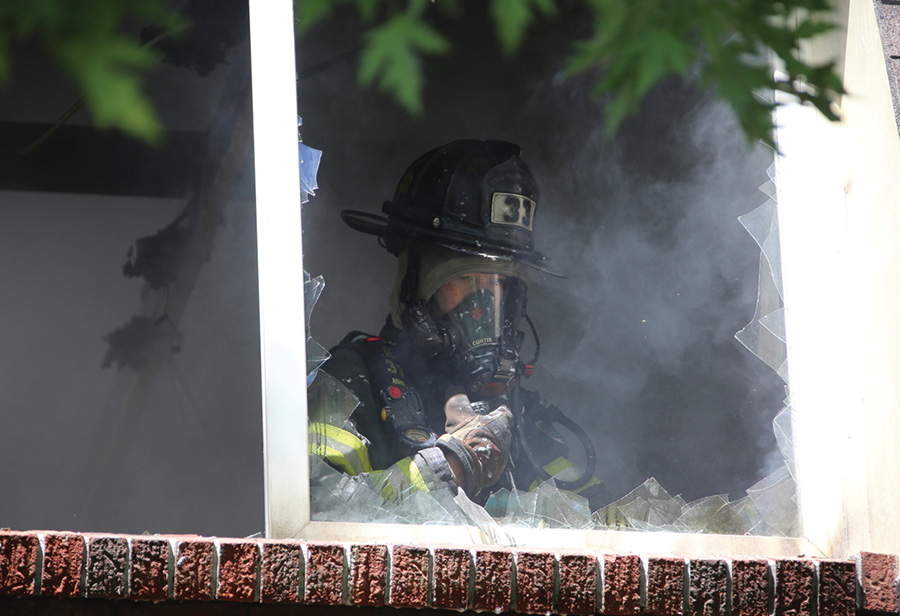
Emergency Communications
Your department should have an SOP for emergency communications that you need to know and follow.
Injured member. If a firefighter is injured, immediately notify the chief. Tell him the firefighter’s assigned job, his injury, his location, and any help needed to remove him. Depending on your department’s policy, you may want to include the injured firefighter’s identity.
“Ladder 1 to Battalion, my roof man has fallen down the stairs and injured his leg. He is on the third-floor rear landing. Have the firefighter assist team (FAST) respond to remove him.”
Missing member. If a firefighter is missing, notify the chief of his unit, his assigned position, his assigned task, his last known location, and any relevant fire conditions and hazards. This information will help the chief send the FAST truck to the most likely location where he might be found and to decide if existing assignments need to be changed or if additional units must be assigned to assist in the search or to prevent the spread of fire.
“Mayday, Mayday, Mayday, Ladder 1 to Battalion, my can man is missing and not responding to his radio. He was in the rear of the fire apartment. Fire has cut off our access to the rear. We need a second line here.”
Relief needed. If your air is running out or if fire conditions are debilitating, let the chief know in enough time so that he can assign relief for you before you must back out. Backing out without your relief in place could leave other firefighters at risk.
Structural Concerns
Structural hazards. Notifying the chief of existing structural hazards is crucial. Although the structural hazard you see may not seem too serious, the chief may combine your on-scene report with the reports of others, consider their ramifications, and see an impending disaster. Plaster falling from the ceiling may not seem too bad a problem to you, but combined with creaking noises, the exposure of floor beam ends, or a sagging floor above, it all portends collapse. Each item alone might not raise a red flag, but what you see and report along with what others report to the chief may give him enough information to make a lifesaving decision. You must relay to the chief the location, extent, and severity of a discovered collapse potential.
Unusual configuration. Any number of building configurations, if unknown, can cause serious problems for firefighters. The presence of split levels in private dwellings or apartments can confound accurate communications, resulting in misdirected line placement and calls for help that result in assistance being delayed as firefighters are sent to the wrong floor. A similar problem occurs when the first floor, the basement, and the cellar are not clearly defined. If one firefighter’s basement is another firefighter’s first floor, then confusion results. If this occurs, the chief can resolve the issue by announcing what floor he is designating as the first floor. This information must be relayed to later incoming units.
Unexpected occupancy/contents. Report to the chief the discovery of propane cylinder storage in the building’s basement or unexpected hazardous materials storage anywhere in a building. He may change tactics, request additional/specialized help, or order the building evacuated. Finding that all of the rooms in a private dwelling or in an apartment are padlocked could indicate that the building is a single-room occupancy, increasing the possible life hazard. Given this information, the chief may request additional trucks to assist in searches.
Height difference front to rear. This is another issue that can confound communications. Some buildings have fewer stories in the front than in the rear because of a lower rear grade. If when reporting from the rear a firefighter says he sees a victim at a third-floor window, it could trigger a rescue attempt from the front on the third or top floor. The problem is that the third floor as seen from the rear is actually the second floor in front. If the chief is not notified of the height difference from front to rear, the victim won’t be found where the rescue firefighters are assigned to look.
Lack of interior stairs. If the ground level in the rear is a separate occupancy, it may not have stairs connecting it to the next level. In such a case, a fire in the rear occupancy will not be accessible from the first floor and will have to be attacked from the rear. The firefighters entering the building from the front, on the first floor, will be above the fire with no way to attack it. The chief must be made aware of this condition.
Bars on windows/doors. This will delay access and may prevent egress. Notify the chief so that he can alert all to the hazard and assign firefighters to remove the bars, eliminating the hazard by providing both access and egress. Notify the chief of any delays in ventilation or obstructions to egress that firefighters might need in an emergency (photo 4).

(4) Photo courtesy of Miami-Dade (FL) Fire Rescue.
Under construction. A building’s lack of interior integrity while under construction may allow for rapid fire spread and pose hazards to firefighters, dictating a more cautious approach. The chief must have this information and also must ensure that all operating on the scene are aware of it.
Fire/smoke spread. If a fire is behaving in an unusual or unexpected way, it puts firefighters and civilians at risk, and a change in strategy or tactics may be in order. Given the information about the fire’s behavior, the chief can make the needed changes.
Unusual spread. Fire spreading in atypical ways, with unusual speed, or with unusual severity can trap firefighters and make victims unreachable. Again, it may require a change in tactics or strategy. When accurately given changing conditions, the chief can reposition or add hoselines and direct rescue attempts by alternate routes.
Fire Knockdown
If you are operating your hoseline on the fire and it is having no effect, let the chief know. You may not be delivering enough water to extinguish it, the fire may be burning up from below you, or an obstruction may be preventing your stream from hitting the base of the fire. Letting the chief know your problem enables him to try to resolve it. He might send a second line, check the floor below for fire, or attempt to hit the fire from a different direction (photo 5).
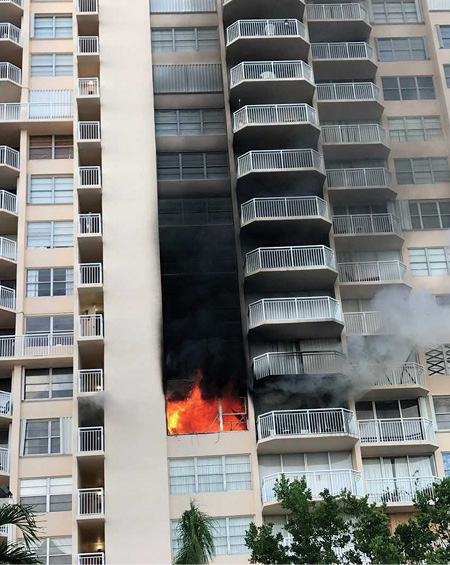
(5) Photo courtesy of Miami-Dade (FL) Fire Rescue.
Under control. Let the chief know when you have knocked down the fire so he can report it under control. Just because your portion of the fire is knocked down does not, however, mean that the fire is under control. That decision is made only after firefighters in all areas of the structure report that the fire is knocked down. Even if you report that the fire is knocked down in your area of the building, fire may be burning and extending in other areas. Hidden fire may need to be exposed by opening up walls, floors, and ceilings or in other areas of the building. The chief may see this from the exterior or receive reports from firefighters in other areas (photo 6).
Relief needed. The chief may automatically relieve you after the knockdown, but he may also not be aware of the severity of the conditions that you faced. If the fire attack was debilitating, request relief from the chief (photo 7).
Hazardous conditions remaining. Notify the chief of any serious hazardous conditions that you are aware of and inform your relief company of hazards in the area where they will be operating.
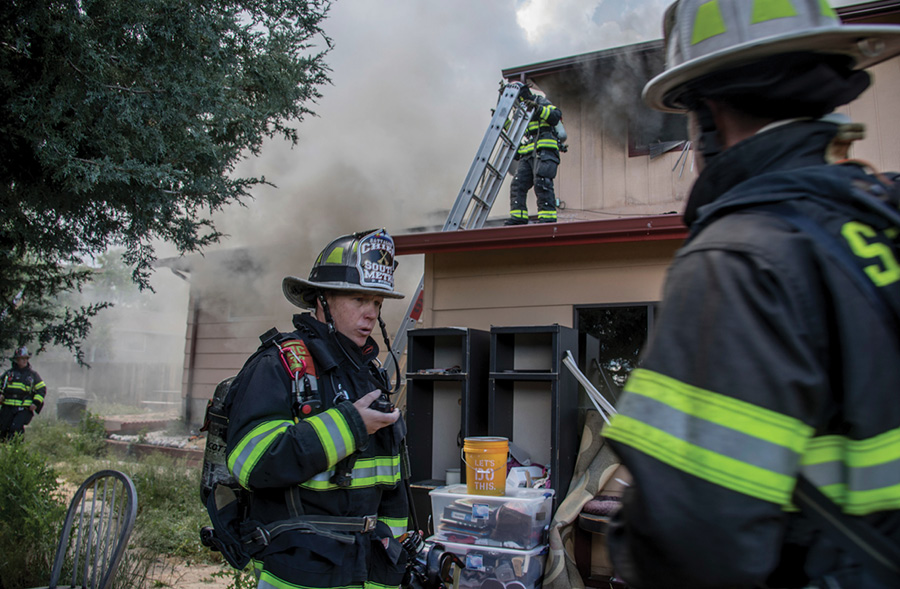
(6) Photo by Eric Hurst.
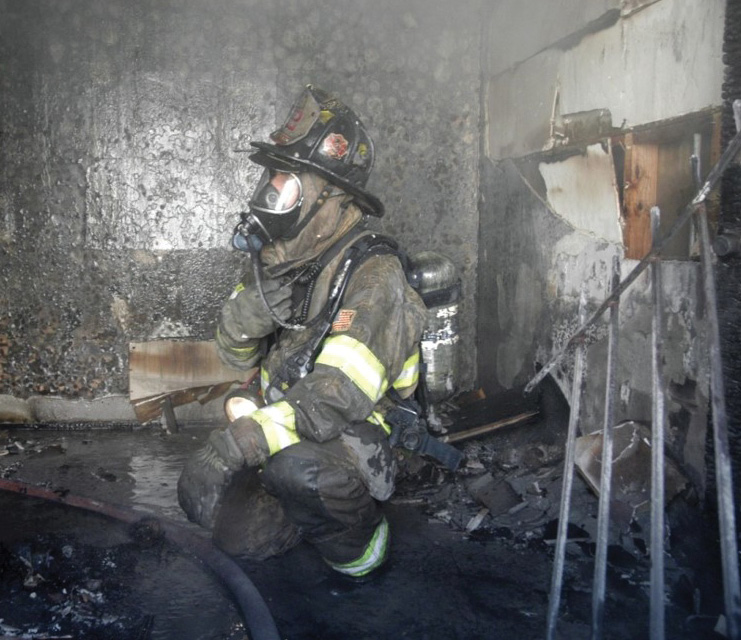
(7) Photo courtesy of Miami-Dade (FL) Fire Rescue.
Taking Up
Report any firefighter injuries to the chief before leaving the scene. If emergency medical services removed firefighters from the scene, ensure that the chief has the relevant information, such as name, injury, and the hospital to which they were taken.
Report any equipment or apparatus damage that occurred at the scene. It may affect your in-service status.
Inform the chief about all forced doors and premises that need to be secured. Leaving the premises unsecured leaves the department and the chief susceptible to legal action. Before leaving, the chief will have to ensure security for those locations.
If there is an electrical or a gas hazard resulting from the fire or the actions of firefighters, let the chief know so he can request the response of the appropriate utility.
At any incident, from beginning to end, the chief collects information needed to make good decisions. Information streaming in to the chief could overwhelm him, so radio discipline is needed. Knowing what should be transmitted to the company officer and what should be transmitted to the chief is important. Firefighters and officers must know what information is relevant and what is not, whom to report to, and what and when to report. One way to figure out what a chief usually wants to know is to listen to what information he asks for at fires and emergencies. Another way is for the chief to use training sessions to inform his firefighters what information he expects from them. Friendly banter, teasing, and other nonrelevant chatter transmitted over the radio are never appropriate at an emergency or a fire scene. They are unprofessional and can interfere with the relay of important information. Imagine the effect of such banter on the poor occupants forced out of their home, standing there watching it burn, or mourning the loss of a family member.
One way to figure out what a chief usually wants to know is to listen to what information he asks for at fires and emergencies.
If you are not a chief officer but are acting as the incident commander, you have the same need for information as the chief. You will be the information gatherer and have to know what questions to ask and whom to ask. So, this information is for firefighters and company officers, who must know what to tell the chief, and for chief officers, who need to collect the information.
There is much more that the chief or incident commander needs to know at fires and emergencies than just the items covered above. What is needed can vary by incident and building type. What is needed at a private dwelling fire will not satisfy the chief at a high-rise fire or a factory fire. What information to relay at various incidents, who should relay it, and when it should be relayed should be on your training calendar. This training is appropriate for probies, seasoned firefighters, and officers. If an incident commander does not receive the information he needs at an incident, he should pursue it aggressively. Without it, his decision making and its results will suffer.
FRANK C. MONTAGNA retired from the Fire Department of New York after 43 years; he was a battalion chief for his last 26 years. He taught courses at John Jay College based on his book Responding to Routine Emergencies (Fire Engineering) and has published more than 40 articles on various aspects of firefighting. He lectures on utility emergencies and fires and other fire-related topics. Montagna serves on the Long Beach (NY) Fire Department’s Training Committee.

